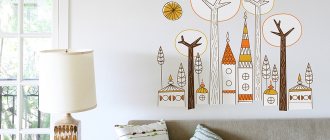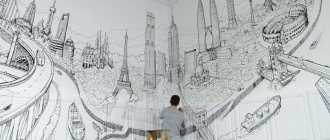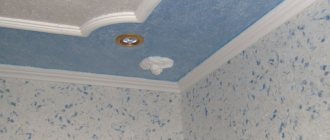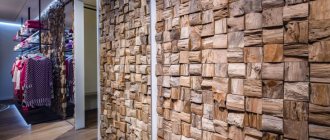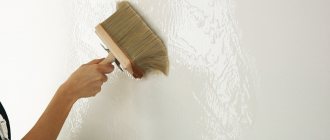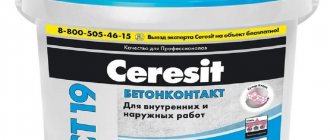How ornament is used in design
Ornament is often called a designer’s assistant, which is not surprising: it unites surrounding objects into a single whole, sets the mood of the interior, and makes it noticeable. If you want to decorate your room with similar decor, think about the following things:
- Color balance of ornament and wall. The color for the pattern is selected taking into account the overall color palette and interior style. In calm versions, it repeats the shade of the wall, but differs by two or three tones, or is related. Sometimes the solution is based on contrast, but there may be restrictions on the application area.
- Environment. When choosing a pattern, take into account the surrounding objects: doors and windows located on the same wall, furniture (with upholstery) that overlaps the background. The combination of the entire set of shades should not tire or irritate.
Ornament on the bedroom wall Source jdmagicbox.com
- Application area. Not every pattern is suitable for application on all four walls. If it is bright, unusual, active in color, limit it to fragmentary use: on an accent wall, or even on part of it. A calm pattern, close in tone and lightness to the background, is suitable for global use.
- The small ornament fits harmoniously into the interior. To make a large pattern look complete, it is chosen based on the size of the room. The guideline is the size of the rapport (a single, repeating motif): the height should include at least 4-5 rapports, and it is highly desirable that they be whole.
Accent wall Source hardrawgathering.com
- If you plan to use several ornaments, a harmonious combination of colors is selected: one (sometimes two) unifying shade should be chosen, tying the composition into a single whole.
Lack of artistic skills cannot be an obstacle to painting on the walls. Stencil is a simple technology that is accessible to beginners and allows you to get high-quality results without excessive costs. The method impresses with its ease of reproduction and excellent results.
Eclectic Source pinimg.com
Tips and tricks for applying a stencil to a wall
In order for the drawing on the wall to look beautiful and even, you need to take the upcoming work responsibly.
DIY stencils for wall decor, basic rules:
- The base for painting and the stencil itself must first be cleaned of dust, dirt, and other elements, and then dried.
- Securely fix the workpiece. You can use tape. Place the middle of the tape on the layout so that one edge of the tape is on the inside and the other on the outside.
- Select the shades of the coloring composition by first checking it on unnecessary cardboard.
- Using aerosol cans, keep it at a distance of thirty centimeters from the surface to be painted.
- When performing a complex composition, break it into several parts. This will help you complete the task accurately and efficiently.
When performing a complex composition, break it into several parts.
Stencils for painting on walls are an affordable and popular tool for decorating a home, office, cafe and other premises.
It is enough to show skill, imagination, follow the recommendations, and a good result is guaranteed.
Stencil: variety of approaches
A stencil is a template that allows you to apply a design to a selected surface. Its main value is that it can be used to create a repeating pattern on any size wall area. You can make a template yourself, buy a ready-made one, or order an individual version from a printing house if you can’t find a suitable ready-made version.
Ready-made (purchased) stencils differ in several parameters. They are made from paint-resistant material; They are rigid and flexible, and according to the nature of application they are divided into two types:
- Disposable. May have several layers. They are made of thin silicone, have an adhesive base and are used for drawing multi-color compositions.
In the recreation area Source pinimg.com
- Reusable. Made from durable and more rigid material, intended for repeated use.
- According to the resulting effect, stencil images are divided into the following types:
- Single color. The ornament is applied in one color; No special skill is required from the performer; simple accuracy is sufficient. This method is the fastest, it is also suitable for obtaining silhouettes or inscriptions.
- Multicolor. The picture turns out to be multi-colored, with shades and transitions, but the work requires more accuracy. The image is applied in several stages, layer by layer; How many layers and stencils there will be depends on the number of colors.
Multicolor solution Source pinimg.com
- Volumetric. To create a three-dimensional pattern, putty is used. A layer of plastic material is applied according to the pattern in a layer of 1-3 mm. The three-dimensional design looks unusual, the relief surface attracts the eye. When the stencil is dry, you can make it more expressive by touching up the protruding parts.
- Anti-stencil (shadow image). In a regular stencil, paint is applied inside the boundaries of the repeat, but here they do the opposite: they paint over the space around the boundaries, simulating a blurred shadow (or highlighting effect) around the silhouette of the design.
There is an alternative method of transferring patterns to the wall: you can draw using a decorative roller. On its rubber surface there is a convex pattern of varying degrees of complexity, which is printed on the wall. Everything is much simpler here: all you have to do is choose the paint (the image will be one color) and prepare the surface. There is also nothing complicated in drawing: the decor is applied using a standard movement.
Applying a pattern with a roller Source blogspot.com
Templates for drawing: purchase or make your own
If you decide to use templates to decorate your apartment, then you will be faced with the question: buy it or make it yourself?
The purchased stencil was professionally made. It has clear lines and can be used more than once. The template is made from durable material and cut out using special equipment - this is its main advantage, but such a template does not allow you to save on wall decor.
A stencil cut out by yourself is cheaper , but it is likely that the lines in the drawings will be uneven. The owner himself must solve this problem. Purchasing a template will take less time than making it yourself.
Types of stencils
Stencils help out when applying repeating complex motifs, successfully replacing manual labor. Ready-made kits differ in their scope of application, and it is useful to understand their diversity in order to choose the appropriate option. The following types of templates are common:
- Simple. The most budget-friendly sets, with a set of simple elements for decoration. They are suitable if you want to depict something simple on the wall. As a rule, the set contains reusable templates of the same size (for example, A4 or A3).
- Wallpaper stencils. They help create an imitation of wall wallpaper. The pattern is combined with itself in two ways: by repeating the pattern or by special alignment marks. The possibilities are varied: from painting flowers on the wall to abstract patterns, intricate ligature of oriental (for example, Indian) ornaments, classical curls and monograms.
Stencil with imitation wallpaper Source plentymarkets.com
See also: Catalog of companies that specialize in finishing materials and related work
- Border stencils. Reusable templates come in a variety of designs. Popular options include classic and ethnic patterns. You can purchase a design with a marine or children's theme, with objects, plants or animals. The set marked “Volume” is suitable for use not only for painting, but also for textured plaster (for liquid wallpaper).
- Angular. Corner elements help to design any rectangular surface: not only walls, but also ceilings, mirrors, furniture, doors. Using four repetitions of one rapport, you can depict a frame or medallion. Corner patterns reproduce different designs: from modern and classic, to abstract and ethno.
Original design Source pinimg.com
- Round. The template can be made in the form of a circle or an ornament that fits into a circle. Round elements are used to decorate a medallion, ceiling decor (under a chandelier) or a watch dial. Sometimes the template is a quarter of the image. If it is reusable, then it is used 4 times to get a complete drawing. If it is disposable, you need to purchase 4 pieces.
Round ornament Source pinimg.com
Choosing a pattern for a room
Usually the ornament, pattern, and individual designs are selected depending on the overall style of the room. The painting can be large or small; often several decors of different sizes are used, but in the same style.
It is important to correctly combine colors and types of patterns so that they look harmonious. Laconic drawings look more expensive and more expressive. It is necessary to take into account the dimensions of the room; decor that is too small will look unremarkable, but you should also not overload the walls with such designs.
For the bedroom
In the bedroom, it is not recommended to paint on the wall with too bright colors, with provocative, sharp contours. The atmosphere should be calm and conducive to good sleep. This is achieved by applying patterns in pastel colors. A pattern in a floral style, geometry or the night sky, stars, or an ornament in romantic colors are good for the bedroom.
For children's
Children usually help themselves in choosing stencils for their room. You can select drawings from the child’s area of interest - cartoon characters, fairy tales, or related to the child’s hobby. Cars and sports are good for boys, flowers are good for girls, and in a teenager’s room you can draw movie and game characters.
For kitchen
Any food-related designs are ideal for the kitchen. These can be fruits and vegetables, elements of tea and coffee ceremonies, dishes and other kitchen utensils. You can paint flowers in the kitchen - they will look harmonious.
For the living room
In the largest room, often called the hall, the whole family gathers and guests are received, so more attention should be paid to the choice of picture. Typically, a symmetrical floral pattern with a woody theme is used here. If the interior style allows, you can try the contours of animals, birds, flowers, and geometry. Pictures can be successfully placed behind the sofa, as a decoration for a door, TV, or headset.
For the hallway
More often, drawings are made in the hallway to highlight the area of the mirror and closet. Usually the pictures are symmetrical, but it is possible to apply an original design to the entire wall.
Popular varieties
The following stencil styles are popular:
- In the Art Nouveau, Art Deco and Art Nouveau style: all kinds of borders and panels depicting birds, fish and animals, floral and floral patterns. White patterns on dark-colored walls always look stylish.
- To decorate modern interiors, abstract motifs are chosen: combinations of figures, optical illusions, chevron patterns.
- For connoisseurs of oriental and eclectic styles, options with Arabic script based on medieval geometric compositions will be useful.
In retro style Source prosto-remont.net
Among specific images, the following templates are most often chosen:
- Turkish cucumber, also known as Turkish bean. The pattern, whose homeland is considered to be India or Persia, has become entrenched in European culture under the name “paisley”. Traditionally used in wall decoration and gives the room a touch of mystery.
- Damascus. Symmetrically arranged flowing floral and plant motifs have been known since the early Middle Ages and symbolize the luxury and impeccable taste of the owners of the house. The damask pattern is found in classical interiors (Baroque, neoclassical, Empire), including in the English style.
The main thing is the accuracy of application Source j.etagi.com
- Quatrefoil. A symmetrical pattern symbolizing clover; refers to traditional European symbolism. It consists of four overlapping circles and very vaguely resembles a plant. The pattern organizes the space, and in modern interiors it is used in doses. In elegant classic and retro interiors it can be used to the maximum.
- Chevron. A fashionable print, also known as herringbone. Actively used since the middle of the last century. If the interior is designed in a neutral color palette, the chevron can serve to create an accent wall.
Chevron Source icypohod.rf
Benefits and Features
Stencils for painting walls are an easy way to transform the interior of a room. Their use has a number of positive properties. Experts highlight the following advantages:
- The monochromatic coating gets an interesting transformation:
- A cool detail appears in the usual design, emphasizing the style;
- Opportunity to realize a creative idea;
- Interior renovation is carried out without spending much money;
- Surface imperfections can be covered;
- Focus on a separate area;
- A reason to please the child, children will enjoy this coloring process.
There are ready-made stencils, but you can also make stencils for painting walls yourself.
Stencils for painting walls are an easy way to transform the interior of a room.
How to choose an ornament
If there are no clear recommendations for choosing a location, then with templates the situation is simpler. The pattern is selected based on the overall style of the room, and it is useful to adhere to the following recommendations:
- Do not combine different types of ornaments. If you choose a damask ornament, you should not “improve” it with butterflies - the combination will turn out so-so, and the damask will lose its charm.
- Don't get carried away with decoration. If you are not sure how an overly detailed drawing will look, opt for a more concise option.
- Do not try to use mats with excessively small details. Firstly, they are not easy to paint neatly. Secondly, small fragments ultimately worsen the impression, since from a distance they resemble spots.
- Pictures that have a lot of jumpers look more beautiful, that is, all the details of the image are interconnected.
Stylized four-leaf clover Source inmyroom.ru
Type of stencil for different premises
The patterns are universal and suitable for any room. These are landscape and natural motifs. There are a large number of them on sale; how the pattern will look is also affected by the paint color you choose.
There are also themed options that suit a specific type of room. This is a marine theme, children's drawings.
The patterns are universal and suitable for any room.
Wall painting: where to start
Stencil painting is a quick and high-quality way to decorate walls. But before you get to work, you need to take care of the following things:
- Prepare the surface. The stencil technique can be performed on any clean surface. The wall is cleaned of dust and dirt, and if possible, vacuumed or washed. If the base is wallpaper for painting, you can do without cleaning.
- Stock up on levels. It will help to apply vertical and horizontal marks and will prevent the drawing from deviating from its intended position.
- Prepare tools. You will need 2-3 brushes of different sizes, a roller or sponge. Spray adhesive will be useful; it will help firmly fix the stencil on the wall.
Volumetric stencil Source decoratorist.com
- Choose paint. The choice is quite varied. Acrylic or tempera paints are suitable for work; you can use regular gouache or a can of spray paint (if you have similar experience).
Beginners who do not know how to paint on a wall are advised to use a brush with caution. Excess paint from its tip can get under the stencil and ruin the design. The spray works faster and the paint layer is more even.
It is also better to choose moisture-resistant paints of medium consistency for work, then the image will be more durable. If you have not worked with stencil technology before, limit the number of colors to three.
Three-color decor Source walldecorbangalore.com
Plastic base
Making stencils from plastic allows us to solve the issue of their durability and washability. Organic glass, plastic alloys, polyvinyl, linoleum - they are all convenient due to their availability and low cost. But cutting the design will require attention and effort - fragile plastic can crack from a hacksaw or cutter, or melt from caustic paint.
Plastic models are good when using enamels and water-based paints, acrylics. Often, plexiglass templates allow you to see whether the paint has gotten beyond the boundaries of the base.
How to make a template
Making a template is a simple process, but in order for the result to be of high quality, the following subtleties must be taken into account:
- Use a material that is suitable for its characteristics: thick paper (for disposable matrices), cardboard or flexible transparent plastic that can fit tightly to the wall (for example, an A4 plastic folder is suitable).
In black and white palette Source yandex.net
Materials
Simple models are made from scrap materials - paper, cardboard, linoleum. Equipment for making stencils is easy to find in any home.
Plastic materials - film, plexiglass, magnetic film - are often used to create silhouettes and ornaments. The use of iron alloys and wood is also common; such templates make it possible to repeat patterns many times and use the base for a long time.
For different types of artistic creativity - for example, body art - templates are also used.
Here it is necessary to comply with special conditions - use a flexible, bendable film that can be attached to the body.
Cars and equipment are painted using magnetic templates that are attached to the surface. The painter’s task is to attach the model to the object as tightly as possible.
What to watch out for when applying ornaments
The process of applying the design is not difficult, but during work you need to remember the following subtleties:
- It is more convenient to attach a template (especially a large one) to the wall with tape, construction tape or special glue.
- After applying one pattern, the template is carefully wiped so as not to spoil the work.
Working with a roller Source archidea.com.ua
- Apply a little paint to the brush. The best method of application is by stuffing, then the paint will not get under the plastic. Excess paint is removed from the sponge by doing a test on an unnecessary sheet of paper.
- When working with a roller, make sure that the paint is applied evenly, especially where the parts are small. When using a spray can, you need to make sure that the colorful aerosol does not get over the edge of the template.
- The stencil is removed immediately after painting, without waiting for the paint to dry.
- If the image is multi-colored, a new shade is applied after the previous one has dried.
Applying paint with a brush Source uiut.boltai.com
What to make a stencil for walls from
Stencils for painting are available for several applications and for 1 application. The possibility of using them several times or once depends on the material used in their manufacture. Paper versions can withstand one-time application of paint. To paint the stencil several times, you can choose the following types:
- Made from vinyl film. There are colored and colorless types; they are periodically cleaned during operation;
- Polyvinyl chloride is the standard choice for working with plaster mortar; after drying, the template is removed;
- Cardboard ones, suitable for home making; cutting out drawings from cardboard is easy.
The possibility of using them several times or once depends on the material used in their manufacture.
Briefly about the main thing
A stencil is an affordable way to create an unusual, eye-catching interior. To ensure a harmonious result, take into account the relationship between a single element and the area of application, as well as color and stylistic balance.
According to the method of use, stencils are divided into single- and reusable, and ready-made stencil designs are single- and multi-color, as well as three-dimensional. The design of the patterns is varied and allows you to choose the desired image for both classic and modern styles, as well as for various details (corner, border).
The template can be purchased ready-made or made independently; You will need cardboard or plastic. It is convenient to apply patterns with a brush, roller, sponge or spray from a can; At the same time, accuracy and knowledge of some subtleties are important.
Ratings 0
Where to get templates
You can find ready-made options on the market; they are usually made from vinyl film. But you can get templates in another way:
- Place an order from organizations that print advertising banners. They can make any image out of vinyl;
- Do the making yourself. Either the patterns are drawn independently, or they are printed and transferred to prepared cardboard. But keep in mind that the process is not easy. It is important to cut out the design beautifully and draw it clearly.
You can find ready-made options on the market; they are usually made from vinyl film.
Film base
A popular option for making a stencil today is to buy self-adhesive film. These are ready-made kits that can be purchased at a hardware store or interior design department.
Such films make the process of decorating a house or apartment as easy as possible. After placing the film on the wall, you can remove the base layer and apply paint with a spray, sponge or brush.
You can make such a model yourself by applying a pattern to adhesive film purchased in rolls at the same hardware store. You can buy cheap colorless or gray film - it will still be removed as a result of coloring design work.
Flexible and soft film for applying designs to the body is not so common, but it can be found in art stores.
User Experience
Making stencils for painting with your own hands is a fairly popular way to decorate a home or office; it is used in creativity and design work. Many artists also do not disdain templates - why waste time on monotonous, monotonous work if there is an opportunity to save time using a model. You can put the release of templates on a commercial basis. Some users set up a stencil making business, which can pay for itself in a few months.
Since many schoolchildren really need different types of templates in the learning process, kits and kits can be supplied to stationery stores or directly to schools. Parents of schoolchildren are a reliable source of income for the manufacturer.
The cost of one copy is low, so it is recommended to consider the option of wholesale supplies and sale of kits. Payback will be based on the number of deliveries and scale of production. You can sell your products quite effectively via the Internet.
The most profitable option is to sell industrial stencils for designers, but the production of the stencil in this case must be of very high quality.
Paper base
Making a stencil from paper is the simplest option that is available to almost everyone.
It is better to take thick paper, sometimes cardboard, which will retain its shape during several paintings.
The paper base is easy to work with - just apply a design and cut it out with scissors or a blade. To apply a complex design with many details, you will need nail scissors and an awl to pierce and cut out delicate details.
